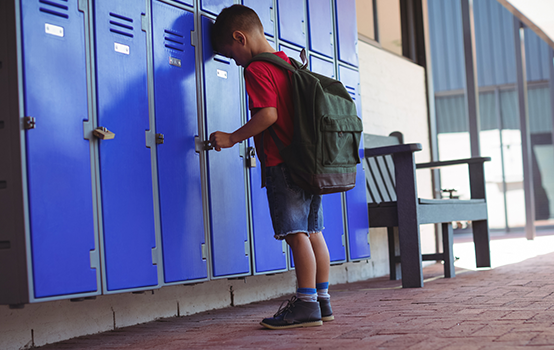Setting numerical goals to remove discipline disparities doesn’t get at the deeper issues.
Whenever I hear education policy wonks arguing about the topic of student suspensions, I’m reminded of the Rorschach tests I learned about in Psychology 101. Show people an inkblot, the theory goes, and the picture that jumps out at them (a butterfly, say, or a monster) will reveal a deeper truth about their personality. Likewise, if you show educators the data on suspensions, some will see appropriate standards for student conduct while others will see evidence of institutional racism. The difference likely depends on whether they value public education mainly as a vehicle for individual advancement or mainly as a public good.
Both views have their merits. On one hand, it’s true that hard-working students should be able to study in peace. No child should have their academic opportunities sabotaged by peers who misbehave in class, or who don’t take their own schoolwork seriously.
On the other hand, it is indisputable that our public schools suspend Black and Latino students at much higher rates than White and Asian students. And that’s not because Black and Latino students misbehave more often. Rather, their teachers tend to punish them harshly for the very same behaviors that earn White and Asian students a warning, at most. In short, the data on suspensions reflect the institutional racism that has always permeated our school systems.
So which is it? Is it a higher priority to protect hard-working individuals from disruptions or to ensure that all groups of students are treated fairly?
As a former superintendent of schools, and a crisis-intervention teacher of severely emotionally disturbed adolescents, I can firmly say that . . . wait for it . . . it depends. As with most dilemmas of educational policy and practice, the truth lies somewhere in the middle.
Unpacking the issues
According to findings from the PDK poll, few Americans regard student discipline to be a significant issue in schools today. Since 1969, the poll has included an open-ended question that asks people what they see as the biggest problem facing public education (inadequate school funding always tops the list). In 1969, 26% of respondents pointed to a lack of student discipline; by 2016, however, that figure had declined to just 9%.
Among school system leaders, however, student discipline continues to be a constant topic of discussion and debate. In part, that’s because of the growing evidence that social-emotional learning — including learning how to regulate one’s behavior — is critical to student success. In part, it’s because researchers continue to find evidence of racial and ethnic disparities in school disciplinary referrals and suspensions. And, in part, it’s because school administrators will always worry about the safety of students, teachers, and staff. If schools can’t provide a safe and orderly environment, then they can’t accomplish any other part of their mission.
Is it a higher priority to protect hard-working individuals from disruptions or to ensure that all groups of students are treated fairly?
But while school system leaders are always thinking about student discipline, that doesn’t mean they have a clear sense of what to do about it. The familiar tools in the superintendent’s toolbox — issuing a memo, launching an initiative, holding an assembly, writing a new policy, providing a staff development seminar, purchasing a new curriculum — may prove to be useful over the long run. The immediate challenge, though, is to wrestle with some extremely tricky questions about the problem at hand: Why, exactly, are students being referred for disciplinary actions? Has something changed in the surrounding neighborhood (e.g., perhaps a local factory has shut down, throwing parents out of work)? Has something changed inside the school (e.g., a new curriculum has been introduced, and students are frustrated)? Or, and as is often the case, does the school’s pattern of suspensions and disciplinary referrals suggest that something more complicated is going on, having to do with race, culture, class, and the ways in which students and teachers interact with one another? In short, how should the problem be framed?
Choosing a frame
In 2012, when I was superintendent of the Montgomery County, Md., school district, we launched an effort to rethink our approach to student discipline and suspensions. At the time, this issue was becoming a hot topic throughout K-12 education, and it was one that touched me personally, given my background working with severely emotionally disturbed adolescents (who often behaved in disruptive ways).
During the summer, I had read Michelle Alexander’s powerful book The New Jim Crow (2010), which argues that in the decades since the civil rights movement, a series of state and federal policy decisions (around drug sentencing, in particular) have led to the incarceration of extraordinarily high levels of Black men. In my opening day speech to administrators, I referenced Alexander at length, pointing out that the school-to-prison pipeline often begins with the decision to suspend Black students for minor classroom offenses. We faced a moral imperative to challenge our own behaviors, I argued, and we should begin by looking closely at our own data, which clearly showed that we were giving disproportionate numbers of suspensions to students of color, often punishing them for “disruption,” “insubordination,” “disrespect,” and other subjectively defined actions.
But our main goal shouldn’t be to reduce suspensions, I argued; when educators set that kind of a numerical target, it becomes tempting (and easy) to manipulate the data. Rather, the goal should be to improve our relationships with students, making sure that each and every child in the system felt valued and had at least one adult they could go to if they had a problem.
As I told the principals, however, I was not going to impose a new program on them. In a district with 25 high schools and 38 middle schools, each with its own context and culture, I knew it would be impossible to mandate a single approach to improving student-teacher relationships. At the same time, though, I knew that this was risky: The most independent and innovative principals would likely find ways to soar, while the self-described “good soldiers” might need more direction.
Still, the results were impressive. Our schools launched a wide range of efforts to improve classroom climate, communication, and teacher-student relationships, and within a couple of years, this had the happy side effect of a 50% reduction in discretionary suspensions and a 37% reduction in suspensions overall, including a significant reduction in racial and ethnic disparities (St. George, 2014). Further, the emphasis on relationships led school leaders to take additional steps to improve school culture, such as by giving students greater voice in classroom decision making and encouraging teachers to take on new leadership roles.
The goal should be to improve our relationships with students, making sure that each and every child in the system felt valued and had at least one adult they could go to if they had a problem.
In one school, for example, students explained to their principal that teachers were too quick to interpret behavior as disrespectful, which led them to become defensive, triggering a back and forth that often ended up with kids getting in trouble. To change this dynamic, the school started a program called Q-TIP (quit taking it personally) that helped the adults in the school learn how to de-escalate conflicts with students. Another school embraced Lisa Delpit’s (2012) concept of a “warm demander,” with teachers committing themselves to balancing their high academic standards and expectations for classroom discipline with efforts to build strong, caring relationships with their students.
If I had declared that all 25 high schools and 38 middle schools must implement the Q-TIP program, or that all teachers in the district had to become warm demanders, I probably would have been laughed out of the room. But having come up with such strategies on their own, teachers and staff embraced them fully, and they made genuine efforts to change the culture of their classrooms and schools.
To be sure, many of our schools continued to struggle. Some teachers, administrators, and parents even reacted with defiance, arguing that I was too soft on kids and that I objected to suspending students even when they committed serious offenses (though I had made numerous public statements to the contrary). Overall, though, I would argue that this approach was much more effective than it would have been had I imposed a program on the entire system. My job was to explain to school leaders that it was critically important to confront our own biased records of disciplinary referrals and suspensions, make it clear that I expected them to find ways to build stronger relationships within their schools, and then give them the parameters within which to do this work. Had I launched a districtwide initiative or framed the goal in numerical terms (i.e., telling each school to achieve a specific reduction in their suspension rate), they would have complied with the directive but missed the deeper purpose. By focusing on the ways adults and kids interact with one another — across the boundaries of race, culture, class, and age — they had to grapple with efforts to understand and improve their own school culture and climate, trusting that this would, in turn, lead to suspensions becoming rarer and more fairly applied.
References
Alexander, M. (2010). The new Jim Crow: Mass incarceration in the age of colorblindness. New York, NY: The New Press.
Delpit, L. (2012). “Multiplication is for White people”: Raising expectations for other people’s children. New York, NY: The New Press.
St. George, D. (2014, July 31). High school suspensions plummet in Montgomery, falling nearly 37 percent. The Washington Post.
Citation: Starr, J. (2018). Reducing suspensions or building relationships? Reframing the problem. Phi Delta Kappan 99 (8), 72-73.
ABOUT THE AUTHOR

Joshua P. Starr
Joshua P. Starr is the managing partner at the International Center for Leadership in Education, a division of HMH, based in Boston, MA. He is the author of Equity-based Leadership: Leveraging Complexity to Transform School Systems.










